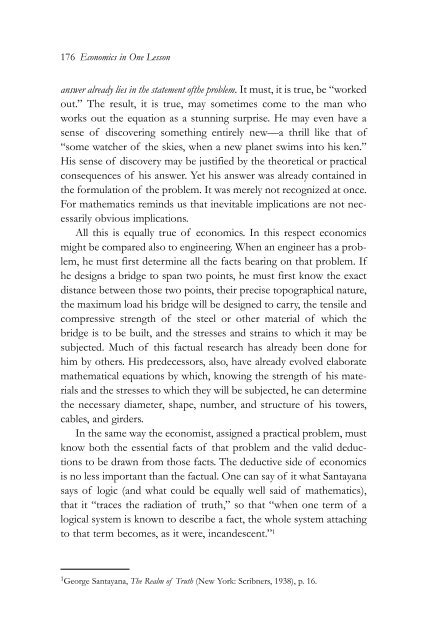1gDdM7w
1gDdM7w
1gDdM7w
- No tags were found...
You also want an ePaper? Increase the reach of your titles
YUMPU automatically turns print PDFs into web optimized ePapers that Google loves.
176 Economics in One Lessonanswer already lies in the statement ofthe problem. It must, it is true, be “workedout.” The result, it is true, may sometimes come to the man whoworks out the equation as a stunning surprise. He may even have asense of discovering something entirely new—a thrill like that of“some watcher of the skies, when a new planet swims into his ken.”His sense of discovery may be justified by the theoretical or practicalconsequences of his answer. Yet his answer was already contained inthe formulation of the problem. It was merely not recognized at once.For mathematics reminds us that inevitable implications are not necessarilyobvious implications.All this is equally true of economics. In this respect economicsmight be compared also to engineering. When an engineer has a problem,he must first determine all the facts bearing on that problem. Ifhe designs a bridge to span two points, he must first know the exactdistance between those two points, their precise topographical nature,the maximum load his bridge will be designed to carry, the tensile andcompressive strength of the steel or other material of which thebridge is to be built, and the stresses and strains to which it may besubjected. Much of this factual research has already been done forhim by others. His predecessors, also, have already evolved elaboratemathematical equations by which, knowing the strength of his materialsand the stresses to which they will be subjected, he can determinethe necessary diameter, shape, number, and structure of his towers,cables, and girders.In the same way the economist, assigned a practical problem, mustknow both the essential facts of that problem and the valid deductionsto be drawn from those facts. The deductive side of economicsis no less important than the factual. One can say of it what Santayanasays of logic (and what could be equally well said of mathematics),that it “traces the radiation of truth,” so that “when one term of alogical system is known to describe a fact, the whole system attachingto that term becomes, as it were, incandescent.” 11 George Santayana, The Realm of Truth (New York: Scribners, 1938), p. 16.


